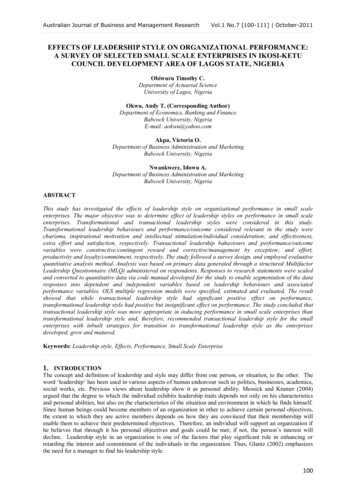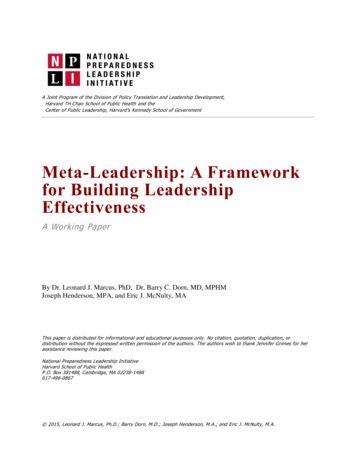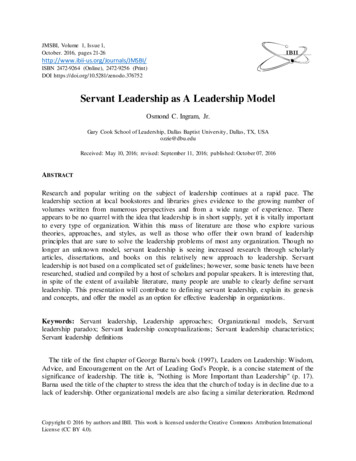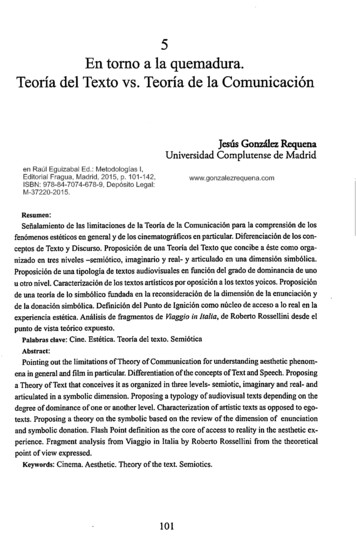
Transcription
Copyrighted material
Unless otherwise indicated, all Scripture quotations are from The ESV Bible (The Holy Bible, English Standard Version ), copyright 2001 by Crossway, a publishing ministry of Good News Publishers. Used by permission. All rights reserved.Verses marked niv are from The Holy Bible, New International Version , NIV . Copyright 1973,1978, 1984, 2011 by Biblica, Inc. Used by permission. All rights reserved worldwide.Cover design by Harvest House Publishers, Inc., Eugene, OregonPublished in association with the literary agency of Wolgemuth & Associates. Inc.THE LEADERSHIP STYLE OF JESUSCopyright 2013 by Michael YoussefPublished by Harvest House PublishersEugene, Oregon 97402www.harvesthousepublishers.comLibrary of Congress Cataloging-in-Publication DataYoussef, Michael.The leadership style of Jesus / Michael Youssef.pages cmISBN 978-0-7369-5230-9 (pbk.)ISBN 978-0-7369-5231-6 (eBook)1. Leadership—Religious aspects—Christianity. 2. Jesus Christ—Example. I. Title.BV4597.53.L43Y68 2013253—dc232013007367All rights reserved. No part of this publication may be reproduced, stored in a retrieval system, ortransmitted in any form or by any means—electronic, mechanical, digital, photocopy, recording,or any other—except for brief quotations in printed reviews, without the prior permission of thepublisher.Printed in the United States of America13 14 15 16 17 18 19 20 21 22 / VP-JH / 10 9 8 7 6 5 4 3 2 1Copyrighted material
To my wife, Elizabeth,and my children, Sarah, Natasha,Joshua, and JonathanCopyrighted material
AcknowledgmentsI wrote an abbreviated version of this book back in 1986.Since then it has been read by millions around the worldin twelve of the world’s most spoken languages.I am confident that this expanded and much enlargedbook will help many leaders and aspiring leaders to follow in the leadership style of Jesus, the greatest leaderwho ever lived.For this I want to thank Harvest House Publishers fortheir vision and the diligence of Wolgemuth and Associates. Above all, I want to thank my very able compilerand editor, Jim Denney.Copyrighted material
ContentsPart 1: The Beginnings of Leadership1.2.The Need to Be Confirmed. . . . . . . . . . . . . . . . . . . 11Acknowledging Those Who HaveGone Before . . . . . . . . . . . . . . . . . . . . . . . . . . . . . 21Part 2: The Qualities of Leadership3.4.5.6.7.8.9.The Leader as Shepherd. . . . . . . . . . . . . . . . . . . . . 31Man’s Rules Versus God’s Principles . . . . . . . . . . . 45Courage . . . . . . . . . . . . . . . . . . . . . . . . . . . . . . . . 53Gentleness. . . . . . . . . . . . . . . . . . . . . . . . . . . . . . . 63Generosity. . . . . . . . . . . . . . . . . . . . . . . . . . . . . . . 71Truthfulness . . . . . . . . . . . . . . . . . . . . . . . . . . . . . 79Forgiveness. . . . . . . . . . . . . . . . . . . . . . . . . . . . . . 87Part 3: The Temptations of Leadership10. Power . . . . . . . . . . . . . . . . . . . . . . . . . . . . . . . . . . 9911. Ego. . . . . . . . . . . . . . . . . . . . . . . . . . . . . . . . . . . . 11512. Anger . . . . . . . . . . . . . . . . . . . . . . . . . . . . . . . . . . 121Part 4: The Problems of Leadership13.14.15.16.The Lonely Calling. . . . . . . . . . . . . . . . . . . . . . . 133Doubters. . . . . . . . . . . . . . . . . . . . . . . . . . . . . . . . 145Criticism. . . . . . . . . . . . . . . . . . . . . . . . . . . . . . . 153Molehills and Mountains . . . . . . . . . . . . . . . . . . . 167Part 5: The Future of Leadership17. Where Leaders Come From . . . . . . . . . . . . . . . . . 17718. Turning Followers into Leaders. . . . . . . . . . . . . . . 187Notes. . . . . . . . . . . . . . . . . . . . . . . . . . . . . . . . . . 199Copyrighted material
Copyrighted material
— Part 1 —TheBeginningsof LeadershipCopyrighted material
Copyrighted material
1The Need toBe ConfirmedAfriend once gave a talk to a group of children. Robed likea character from Bible times, he said, “I have something totell you—something I’ve never told anyone else before.” He pulledopen the robe to reveal a big S on his T-shirt. “Kids,” he said, “I’mSuperman!”The children laughed. One child called out, “If you’re Superman,fly up to the ceiling!”My friend went on to explain that many people make claimsabout who they are, but not everyone can offer proof. “The problem,” he said, “is that once I tell you I’m Superman, I have to proveit.”Leadership works the same way. Whenever anyone says “I’m aleader,” that person will be put to the test. He or she must back thatclaim with proof. What kind of proof ? Well, the most obvious kindof proof that a person is a leader is that he or she has followers. If youdon’t have followers, you are not a leader.Followers are people who believe in you and trust you enoughto follow in your footsteps. They endorse your leadership by sayingto you, “I recognize your leadership ability. I trust you. I want to belike you. I want to learn from you. I want to go where you lead me.”A leader is, by definition, a person who works through otherpeople to achieve a goal or a vision. A president sets a vision or direction for the nation, then commissions his staff and his cabinet toachieve that vision, works with Congress to enact that vision, and11Copyrighted material
12The Leadership Style of Jesusinspires the citizenry to embrace that vision. A corporate CEO castsa vision for the company, works through the management team toimplement that vision, and motivates the workforce to fulfill thatvision at every level. A pastor articulates a biblically based vision forthe church, and works through the church board, the elders anddeacons, the teachers and youth workers and volunteers, and allthe members to transform that vision into Christ-centered ministry.The ultimate role model of effective leadership is Jesus Christ. During his earthly ministry, Jesus worked through people to achieve thevision called “the kingdom of heaven.” He began by calling to himself a circle of twelve people from assorted temperaments and backgrounds, including fishermen (Simon, Andrew, James, and John),antigovernment political extremists (Simon the Zealot and JudasIscariot), and a pro-government collaborator (Matthew the tax collector). Jesus mentored these followers, taught them and challengedthem, and united them into a unified force focused on a singlegoal. Then he pushed them out of their comfort zones and delegated important tasks to them, and ultimately founded his churchthrough them.Jesus worked through the Twelve to establish a church that hasendured for two millennia and now circles the globe. Jesus inspiredtrust and followership in the people he met. As they followed andwatched his life, they became witnesses, confirming that he truly wasthe Messiah—the leader promised in the Old Testament, anointedby God, descended from David, and sent to save his people.Jesus also shared his vision with a wider circle of disciples andwith the masses, and he inspired confidence and enthusiasm abouthis vision of a coming kingdom. In the process of casting his kingdom vision and teaching in parables, he enabled people to see hisvision for themselves, and he drew many people to his vision. Jesusthe Messiah created a community of people who were focused onhis kingdom vision, and by leading, teaching, motivating, andinspiring those people, he changed the world.Copyrighted material
The Need to Be Confirmed13As we see in John’s gospel, Jesus offered seven basic proofs, sevendistinct confirmations that he was truly the Messiah, God’s anointedleader. After we examine those seven proofs, we will see how to applythe lessons of the leadership style of Jesus to every leadership arena—governments and corporations, churches and schools, military unitsand sports teams, and the most intimate leadership arena of all, thehome.First Witness: The FatherThe first proof Jesus offers to confirm his leadership role is thewitness of God the Father. He told his hearers, “And the Fatherwho sent me has himself borne witness about me” ( John 5:37a).What did Jesus mean? He was speaking about the Father’s stamp ofapproval—an affirmation that God issued publicly, immediatelyafter Jesus was baptized by John the Baptist. In Matthew’s gospelwe read:And when Jesus was baptized, immediately he went upfrom the water, and behold, the heavens were openedto him, and he saw the Spirit of God descending likea dove and coming to rest on him; and behold, a voicefrom heaven said, “This is my beloved Son, with whomI am well pleased” (Matthew 3:16-17).In the presence of John the Baptist and many other witnesses,God the Father openly announced his eternal relationship betweenhimself and Jesus of Nazareth. Here we see a stark contrast betweenJesus and every other so-called “messiah” who claims to come inthe name of God. For example, Joseph Smith, the founder of Mormonism, claimed he was all alone at night on a wooded hill when hewas visited by an angel; that angel, he said, revealed a new religionto him out of a book of golden plates. Muhammad, the founder ofIslam, supposedly entered Jerusalem by night and claimed to hearthe voice of God speak to him while he was alone.Copyrighted material
14The Leadership Style of JesusGo through the history of various religions and you hear repeatedclaims of “in the middle of the night, when no one else was around,God spoke to me.” But Jesus did not have to make unverified claimsof a revelation by night. God the Father openly confirmed his Sonas the anointed Messiah.On a less public occasion, Jesus took his three closest disciples,his executive committee as it were, to a mountain (later known asthe Mount of Transfiguration). What these three disciples witnessedthat night is recorded in Mark’s gospel:And after six days Jesus took with him Peter and Jamesand John, and led them up a high mountain by themselves. And he was transfigured before them, and hisclothes became radiant, intensely white, as no one onearth could bleach them. And there appeared to themElijah with Moses, and they were talking with Jesus. AndPeter said to Jesus, “Rabbi, it is good that we are here.Let us make three tents, one for you and one for Mosesand one for Elijah.” For he did not know what to say,for they were terrified. And a cloud overshadowed them,and a voice came out of the cloud, “This is my belovedSon; listen to him.” And suddenly, looking around, theyno longer saw anyone with them but Jesus only (Mark9:2-8).The messiahship of Jesus was confirmed as Jesus conversed withElijah and Moses, and as the voice of God said, “This is my belovedSon.” Jesus was not a self-proclaimed, self-anointed leader. His rightto be called Jesus the Messiah was proclaimed by God the Father,and that proclamation was heard by many witnesses.Second Witness: John the BaptistThe opening chapter of John’s gospel reveals the testimony of asecond witness, John the Baptist:Copyrighted material
The Need to Be Confirmed15And John bore witness: “I saw the Spirit descend fromheaven like a dove, and it remained on him. I myself didnot know him, but he who sent me to baptize with watersaid to me, ‘He on whom you see the Spirit descend andremain, this is he who baptizes with the Holy Spirit.’And I have seen and have borne witness that this is theSon of God” ( John 1:32-34).As Jesus later said of John the Baptist, “You sent to John, and hehas borne witness to the truth” ( John 5:33). John the Baptist, whocalled himself “the voice of one crying out in the wilderness,” was aforerunner and a witness for Jesus, a man sent by God with a uniqueministry to confirm to the world the identity of Jesus the Messiah.Third Witness: Jesus HimselfIt may seem strange that Jesus called himself to the witness standto testify to his own ministry as God’s anointed Messiah. But afterreferring to the confirming witness of his Father and John the Baptist, Jesus said, “But the testimony that I have is greater than that ofJohn. For the works that the Father has given me to accomplish, thevery works that I am doing, bear witness about me that the Fatherhas sent me” ( John 5:36).Later, Jesus said, “I and the Father are one” ( John 10:30). Hishearers understood exactly what he was saying, and they picked upstones to stone him to death. They justified their intention to kill him,saying, “It is not for a good work that we are going to stone you butfor blasphemy, because you, being a man, make yourself God” ( John10:33). On another occasion, Jesus told the people that because theyhad seen him, they had seen God the Father (see John 14:7).Jesus didn’t merely claim to have a unique and eternal relationship with God. Everything about his life backed up this claim.Through the evidence of his life, Jesus made it clear that he was aleader to be followed.Copyrighted material
16The Leadership Style of JesusFourth Witness: The Holy SpiritAs we have already noted, the Holy Spirit gave his blessing andconfirmation at the baptism of Jesus by descending on him like adove and remaining on him. Even though the story is presented tous beautifully, in symbolic language, there are undoubtedly depthsto the witness of the Spirit in the life of Jesus that we don’t fully comprehend. But we do know that the Holy Spirit confirmed the ministry and leadership of the Lord Jesus. The presence of the Spiritgave Jesus the authority to preach the gospel and perform a variety of miracles.Fifth Witness: ScriptureThe Old Testament confirmed the leadership of Jesus. Prophetsforetold his coming, his messianic ministry, and his death. Some ofthe most explicit prophecies about Jesus were written by the prophetIsaiah. He pictured the birth of Jesus (Isaiah 9:6), the suffering ofJesus (Isaiah 53:4-10), the servanthood of Jesus (Isaiah 42:1-4), andeven the announcement of Jesus by John the Baptist (Isaiah 40:3).Many other messianic passages, such as Psalms 22, 69, 110, and 118,speak vividly of Jesus’s life, ministry, lordship, rejection by Israel,death, and resurrection.As the Lord Jesus told the corrupt religious leaders who persecuted him, “You search the Scriptures because you think that inthem you have eternal life; and it is they that bear witness about me,yet you refuse to come to me that you may have life” ( John 5:39-40).Sixth Witness: MiraclesThe ministry of Jesus was confirmed by the miracles he performed. John’s gospel refers to them as “signs.” Though John citesfewer miracles than any of the other gospel writers, the signs he mentions bear witness to the purpose, power, and leadership authorityof Jesus.Copyrighted material
The Need to Be Confirmed17It’s important to understand that Jesus did not perform thesesigns as an act of showmanship. An attention-seeking showmanwould have performed magic tricks to amaze and attract the crowds.Jesus often performed his most amazing miracles quietly, out ofpublic view, and he frequently told witnesses to tell no one. Hisreluctance to perform miracles in order to play to the crowd confirms his words, “I do not receive glory from people” ( John 5:41).Seventh Witness: The DisciplesThe disciples traveled with Jesus throughout his earthly ministry.They saw what he did, heard his teachings, and believed. When thereligious leaders persecuted Jesus and he spoke openly of the hardship of following him, many would-be disciples turned away. Onlya few continued to follow him.Those who persevered with Christ included Simon Peter, whosaid, “Lord, to whom shall we go? You have the words of eternallife” ( John 6:68). In saying that, Peter didn’t merely mean that Jesusknew the rules of life or could explain how life should be lived; hemeant that Jesus himself was the Source and Giver of eternal life.The author of the gospel of John was himself a follower of Jesus.In the next to last verse of his gospel, John says, “This is the disciple who is bearing witness about these things, and who has writtenthese things, and we know that his testimony is true” ( John 21:24).Today’s LeadersWe who are involved in leadership today can hardly claim to possess the unique qualifications of Jesus the Messiah. But by observing his life, we learn this important leadership principle: The call toleadership must be confirmed.What if someone walked into your office and said, “I have cometo lead you into truth”? First, such an approach would be so strangethat you’d probably call security to have that person removed.Copyrighted material
18The Leadership Style of JesusBut suppose something about this person’s manner made youwant to examine his claims. How would you know who he was?How would you test the validity of his claim? How would you knowif this person could lead you to the truth or not? You would undoubtedly ask a few reasonable questions: “By what right or authority doyou speak? What are your qualifications or credentials? Could I seeyour résumé? Do you have any references?”A person cannot simply come out of nowhere and expect to befollowed as a leader. A leader must prove himself or herself competent to lead. This is true whether one is a leader in the religious realmor the secular realm.A pastor of a church must overcome a number of hurdles toachieve a position of leadership. Normally, a pastor is first trained,then ordained (formally recognized as someone called by God asa spiritual leader). Anyone can train for leadership, but only Godcalls people to spiritual leadership. Pastors generally serve apprenticeships that allow them to grow into leadership, to become intellectually, emotionally, and spiritually more mature. Throughoutthis process, church leaders and members have an opportunity toobserve and recognize the pastor’s unique gifts and abilities.Authentic spiritual leaders are also confirmed by people outsidethe church. The apostle Paul, when giving instructions to his protégé, Timothy, on the subject of ordination, said that an authentic spiritual leader “must be well thought of by outsiders, so that hemay not fall into disgrace, into a snare of the devil” (1 Timothy 3:7).This rule of confirmation applies in secular leadership settings aswell. Whether in business, government, the military, academia, oreven the home, people must earn the right to lead. I may believe that Ihave been divinely appointed to head Apple Computer, but if I walkedinto Apple headquarters in Cupertino, California, and announced,“I’m here to take over,” I assure you they would not usher me into theCEO’s office. Most likely, I would be ushered to the parking lot.Copyrighted material
The Need to Be Confirmed19If I would like to become the CEO of a major corporation, I willhave to go through a process of confirmation. I will have to start atthe bottom and be patient. I’ll have to listen, learn, be mentored andinstructed, demonstrate initiative and creativity, acquire skills, makefriends and influential connections, and gradually move up the corporate ladder. At each level of my career, some individual—or morelikely, a group of individuals—will have to examine my work, assessmy character, and say, “Yes, he’s ready. He has earned a chance tomove up to the next level.”Many would-be leaders lack the patience to climb that ladder.Full of hubris and the arrogance of youth, they don’t even know howmuch they don’t know. So they vainly insist that they have what ittakes to lead.I have learned over the years how to separate in the interviewstage the leadership contenders from the pretenders. The most obvious sign of a pretender is a candidate who tells you that your organization is desperate for someone with his ability and he will save yourorganization. That kind of arrogance is always a red light.I remember one candidate for ministry who was turned down bya church and told to wait until he had gained more experience andmaturity. His embittered response: “You are going against God’swill.” The people on the committee were all friends of his. Theywanted the best for him. But they were also committed to confirming God’s call on his life, and at that point, they simply could notdo so in good conscience. They saw too many character flaws in thisman, and his impatient and prideful reply only confirmed that theywere right about him.I have also seen, in both the Christian and secular worlds, peoplewho looked great on paper, who had impressive résumés, but whoproved incapable of leading once they were hired and placed in thehot seat. They didn’t have the aptitude to lead, and they lacked theconfirmation of other people.Copyrighted material
20The Leadership Style of JesusAll authentic leaders must be confirmed in order to lead. Thisbrings us to the first leadership principle we learn from the life ofJesus:Principle 1Even Jesus received confirmation as a leader.We too must be confirmed as leaders.Copyrighted material
the lessons of the leadership style of Jesus to every leadership arena— governments and corporations, churches and schools, military units and sports teams, and the most intimate leadership arena of all, the home. First Witness: The Father The first proof Jesus offers to conf











